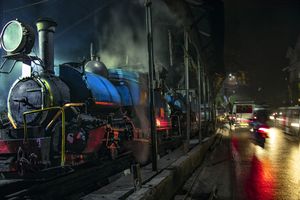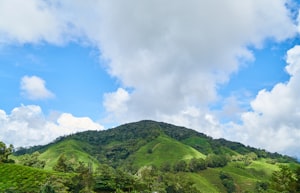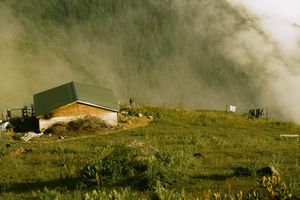Darjeeling Himalayan Railway: A Journey through the History of the Toy Train
The History of the DHR Toy Train Darjeeling, celebrated for its tea gardens and scenic beauty, also boasts a unique historical gem that has captured the hearts of people worldwide—the iconic Darjeeling Himalayan Railway (DHR), affectionately known as the "Toy Train." This enchanting story dates back to the 1800s
Oct 19, 2023 4 mins

TOC
The History of the DHR Toy Train
Darjeeling, celebrated for its tea gardens and scenic beauty, also boasts a unique historical gem that has captured the hearts of people worldwide—the iconic Darjeeling Himalayan Railway (DHR), affectionately known as the "Toy Train." This enchanting story dates back to the 1800s when Darjeeling had already established itself as a renowned hill station and health resort.
During this era, India was under British colonial rule, and many English families, primarily from Calcutta (now Kolkata), flocked to Darjeeling for vacations. The resulting surge in tourism led to increased traffic in the region, despite the lengthy and cumbersome journey from Kolkata to Darjeeling. This arduous expedition involved a 219-mile steam engine-hauled train ride to Sahibgunj, followed by river crossings via steamer and bullock cart, eventually reaching Siliguri, over 100 miles from Darjeeling. From Siliguri, travelers had to rely on bullock carts or horse carriages (tongas) for a two-day journey to Darjeeling's hill town.
To alleviate this inconvenience, the privately owned Eastern Bengal Railways (EBR) extended the railway line from Calcutta to Damukdia, which is now located in Bangladesh. This broad-gauge line spanned 119 miles and required passengers to cross the Ganges to Sara Ghat on the opposite bank. However, EBR refused to extend the lines from Sara Ghat to Siliguri.
Consequently, the government-owned Northern Bengal Railways (NBR) undertook the challenging task of laying 210 miles of railway lines on the opposite bank, completing the remaining stretch in 1878. While the journey to Siliguri could now be accomplished in less than 24 hours, the ascent to Darjeeling's steep hills remained an obstacle neither EBR nor NBR wished to tackle.
The Genesis of the Toy Train
The inception of the Toy Train in Darjeeling can be attributed to Franklin Prestage, an agent of Eastern Bengal Railways who first visited Darjeeling in 1878. Recognizing the need for a railway connecting Siliguri to Darjeeling, Prestage proposed a privately run train on a 2-foot wide track, now known as narrow gauge, running parallel to the Hill Cart Road. His proposal highlighted various advantages, particularly the potential cost savings, as the absence of a railway connection resulted in a significantly higher cost of living in the hills compared to the plains.
This proposal garnered active support from the Lieutenant Governor of West Bengal, Sir Ashley Eden, and was readily accepted by the government. In 1879, the government permitted the formation of the private company Darjeeling Steam Tramway Company, tasked with manufacturing, owning, and eventually operating steam engine-hauled trains to Darjeeling. The railway and track construction commenced in the same year, and the company's name was changed to the Darjeeling Himalayan Railway (DHR) Company in 1881.
Laying tracks along the steep gradients of the hills presented an immense challenge. The narrow gauge line imposed restrictions on the size and weight of the engines, with steel tracks weighing 18.6 kilograms per yard and laid on wooden sleepers. By 1881, the first 31 kilometers of track from Siliguri Town to Tindharia were completed, followed by subsequent sections, culminating in the train's triumphant arrival in Darjeeling on July 4, 1881.
The DHR Toy Train Route
The original DHR track covered a distance of 83 kilometers from Siliguri, but it was later extended an additional 5 kilometers to New Jalpaiguri, making the total track length 88 kilometers. Today, diesel locomotives have replaced steam engines for the end-to-end journey from New Jalpaiguri to Darjeeling, reducing the travel time to approximately 7 hours. However, steam engine-hauled and deiseal trains are still available for shorter round-trip joy rides from Darjeeling to Ghoom .
The DHR route encompasses 12 stations: New Jalpaiguri, Siliguri Junction, Sukna, Rangtong, Tindharia, Gayabari, Mahanadi, Kurseong, Tung, Sonada, Ghoom, and Darjeeling. While there are no alternative DHR routes, shorter train services operate between pairs of stations along the same track.
Engineering Marvels of the DHR Toy Train
The construction of the Darjeeling Himalayan Railway tracks presented unique engineering challenges. Three ingenious engineering solutions set the DHR apart. First, the creation of Double Loops at Chunbhatti and a Single Loop at 'Agony Point' allowed the train to gain elevation on steep gradients. The design was later extended to include the famous Batasia Loop shortly after Ghum.
Second, the concept of Z Reversals or Zigzags emerged when faced with unmanageable gradients. This idea was born during a ball dance when a frustrated contractor, Herbert Rumsey, discussed the problem with his wife, who suggested that if one couldn't move forward, they should go back. This led to the creation of zigzags, where the train reversed and then took a different track to gain elevation.
Remarkably, no tunnels were built through the mountains, except for a small tunnel near Chunbhatti following the 1934 earthquake, which was later abandoned after the 1968 landslides.
The Transition to Government Ownership
By 1944, the DHR boasted 39 steam engine locomotives and a workforce of over 2,000. However, with India's independence, the era of private ownership of the Darjeeling Himalayan Railway came to an end. On October 20, 1948, the Indian government acquired the DHR, and the last English General Manager, James Shaw, oversaw the transition. Despite offers of employment at one-third of their previous salaries, none of the English personnel accepted. On January 15, 1958, the DHR was handed over to the Northeast Frontier Railway (NFR). On December 2, 1999, UNESCO bestowed World Heritage Site status upon the DHR, making it only the second railway in the world to receive such recognition.
Quick Facts
- Total track length of DHR: 88 kilometers.
- Number of stations on the route: 12.
- Number of curves: 873.
- Sharpest curve: Has a radius of 69 feet.
- Steepest gradient (slope): 1 in 18.
- Roll gradient: 1 in 22.5 (indicating the train's rolling during curves).
- Number of bridges: 554.
- Number of loops: 3.
- Number of Z reverses: 6.
DHR Toy Train Joyrides & Regular Services
The Darjeeling Himalayan Railway, or the "Toy Train," has held a special place in the hearts of Darjeeling's residents and visitors since its inaugural journey on July 4, 1881. To experience the joy of riding this historic train, you can visit Darjeeling and embark on a round-trip joyride from Darjeeling station to Ghum. These tourist trains offer options to ride behind either a diesel engine or the traditional heritage steam engine.
Several daily round trips take place between Darjeeling and Ghum, with stops at Batasia Loop and Ghum Station. For an authentic experience, opt for the steam engine train, although it comes at a higher cost due to maintenance expenses.
For more information on DHR Toy Train rides and services, explore the various joyrides and regular service offerings of the Darjeeling Himalayan Railway.



